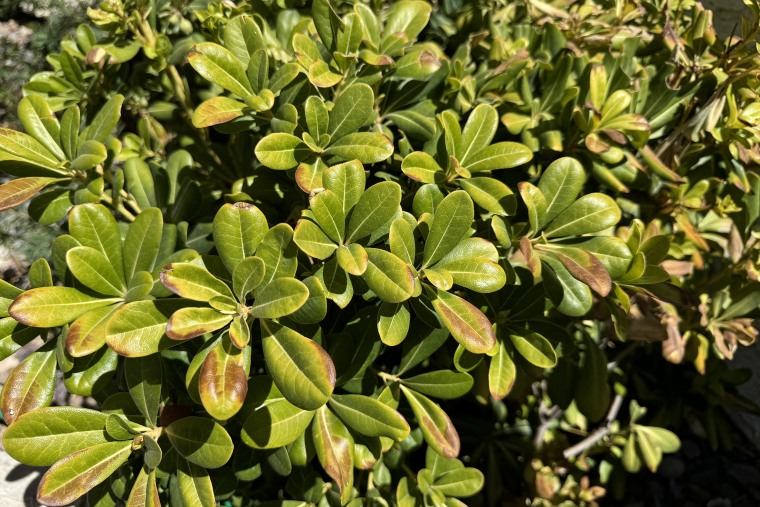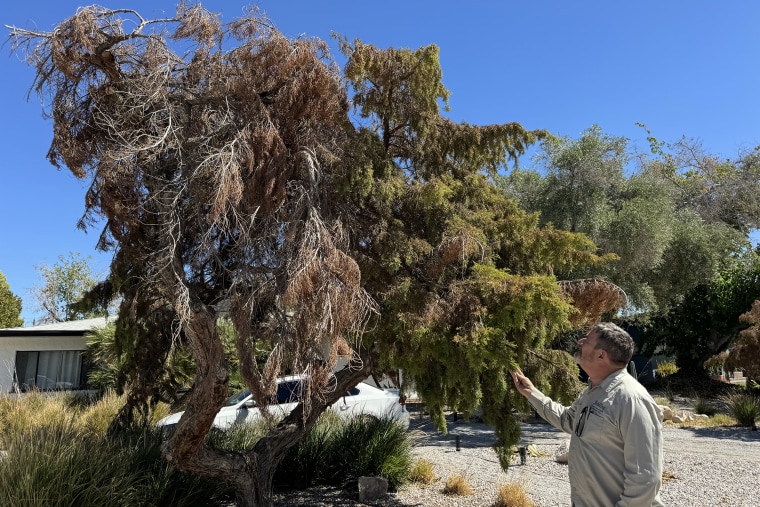
The Summary
- Increasingly frequent and severe heat waves in the Southwest are damaging some desert plants known for thriving in harsh conditions.
- Saguaro cacti and agave have both suffered in sweltering weather this summer and last.
- Ecologists are working to figure out how various species respond to the persistent extreme heat and pinpoint how hot is too hot for them.
LAS VEGAS — On a sun-parched stretch of West Charleston Boulevard, Norm Schilling pulled his truck over to the side of the road just to visit his favorite tree.
Schilling, a local horticulturalist who runs a landscaping company and owns a garden shop called Mojave Bloom Nursery, saved this African sumac decades ago after an unusually frosty winter caused its branches to freeze and die off. With careful pruning, the tree pulled through, but this summer, it’s facing a new danger: months of oppressive heat that have dried out branches and caused dieback in clusters of its drooping foliage.
It’s a seemingly counterintuitive problem. The Southwest is no stranger to sweltering conditions, and desert plants and trees are drought-resistant and heat-tolerant. Arid, harsh environments are where they thrive.
But as climate change makes heat waves more frequent, intense and long-lasting, experts say the increasingly severe conditions are testing some iconic desert plants known for their resilience — including saguaro cacti and agave.
“We saw damage to plants this summer that had never showed heat stress before,” Schilling said.

On a drive around Las Vegas, he pointed out the consequences.
A mock orange shrub on a quiet, residential block was sunburned, with damaged spots where the sun had bleached the tissue of its shiny leaves. Down another street, a pair of mulberry trees were drying out, likely because they had not gotten enough water to cope with the heat. Around the corner, a large juniper tree showed signs of “severe decline,” Schilling said, with dead, brown leaves still adorning withered branches — evidence that the heat damage was recent.
“That juniper is probably close to 40 or 50 years old. It’s a magnificent specimen, but she’s going to die,” he said, then patted and kissed its rough trunk.

Then there was the array of succulents known as gopher spurge a few blocks away, in which some appeared burnt, their sapped and yellowed branches splayed in all directions.
“This species is super dependable and it’s a very common species across the Valley,” Schilling said. “Some of these plants here are just at the point where they’re not going to recover.”
Las Vegas has smashed several heat records already this summer, including its hottest day in recorded history on July 7, when the temperature reached 120 degrees Fahrenheit. A record streak of seven straight days at or above 115 F followed. Temperatures for most of June, July and August stayed in the triple digits, with little relief even at night.
“The heat we’re seeing now is a new paradigm. It’s like the ground is shifting beneath our feet,” Schilling said.
Ecologists across the Southwest are working to figure out how different species respond to the onslaught of heat year after year and just how hot is too hot for desert plants and trees.
Kevin Hultine, director of research at the Desert Botanical Garden in Phoenix, studies the consequences of heat stress on the Sonoran Desert ecosystem. He and his colleagues have been tracking an uptick in saguaro cactus mortality that began in 2020 — when the state was in the midst of a severe, yearslong megadrought — and has not let up.
“Summer of 2020 was our hottest on record until last year, and we saw a major die-off,” Hultine said. “It has been constant ever since, and then obviously 2023 increased the pace even more.”
 Print
Print


